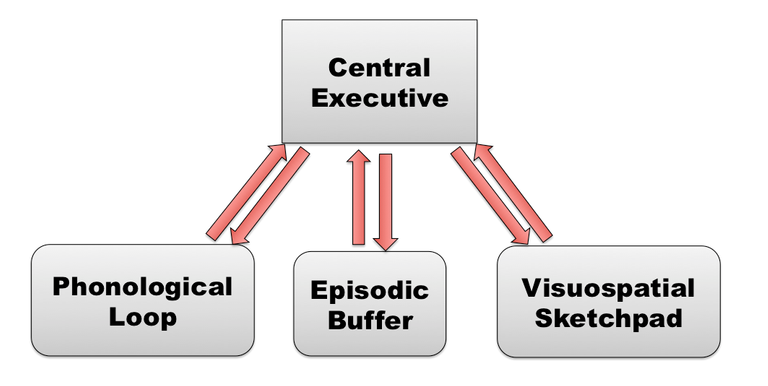Brief Psychology Tutorial: Memory and Memory Theories
Memory is an essential feature to humans and most other living organisms. All of our daily activities – talking, understanding, reading, and socializing – depend on stored information about our surroundings. Our memory has an incredible capacity for storage, but our mind needs to be very selective in what it remembers. Human brains need to be able to combine past knowledge and new information to successfully navigate life. Although our brains and memories can, at times, be likened to storage containers which keep memories, knowledge and information locked up until needed, many psychological theories on memory explain that the former idea is much too simple.
Lefrancois (2000) defines memory as the availability of information and the ability to retrieve previously acquired skills or information. Are they like storage containers or more complex?
Multi-Store Model of Memory and the ‘Magical 7’:
According to Atkinson & Shiffrin’s modal model of memory (1971) memory is constituted of three storage areas: sensory store, short-term store and long-term store (Albery et al, 2004). Our sensory store collects input that is subsequently sent to the short-term store. This theory explains that if the input is rehearsed within 18 seconds of collection, parts of the information will be logged into the long-term store.

Atkinson and Shiffrin built on Miller’s theory of the magical seven. The magical seven explains that roughly 7 pieces of information can be rehearsed at a time (Styles, 2005). According to Atkinson et al we are continuously receiving input, processing it and sending information to our long term storage.
These theories explain that memory is a lot more complex than originally thought. Our memories do not work like simple storage containers that receive input and store the latter behind lock and key. Rather, workers (our memory processes) are continuously sifting for relevance in input and correctly packing, bubble-wrapping and labelling (rehearsing) these.
The Working Memory Model:
Baddeley (1998) thought that Atkinson & Shiffrin’s model was was too simple. He argued that Atkinson et al did not take into account processes by which the information was categorised and stored. Furthermore, he expressed the idea that short term memory (working memory) had different systems to store different types of information. This led Baddeley to come up with the idea of ‘Working Memory’. The term, Working Memory, includes all components of short term memory (STM) and the attention control required to hold, rehearse, and manipulate this information while other processes work on it (Andrade, 2001).

Baddeley identified different components within our memory: the central executive (acts like a supervising boss) the phonological loop (listening to speech) component and the visuospatial (objects in space, and the space between them) component.
The central executive is responsible for monitoring and coordinating the operation of the sub-systems (visuospatial sketchpad and phonological loop) and relates them to Long Term Memory. Therefore, watching an oral presentation means we are not recording every single piece of information given. Our phonological loop and visuospatial pad are retaining the speech base sound and making a mental representation of colour shape and distance respectively (Andrade, 2001).
Baddeley later added the Episodic Buffer to account for failures in experiments trying to concretely prove his theory. The episodic buffer serves as ‘backup-storage’ which communicates with LTM and STM.
How we remember and forget: Levels-of-Processing View
Craik & Lockhart’s Level of Processing Theory (1972) proposed that the resilience (strength and durability) of memories were directly related to the depth and complexity involved at the the time of processing (rehearsing) these (Albery et al, 2004).
Craik et als’ theory directly contradicts the Multi-Store model which represents memory strength as changing in relation to how often it is rehearsed (the implication being that rehearsal leads to storage in LTM) . They argued that rehearsal that consists simply of repeating previous analyses (maintenance rehearsal) doesn't enhance long-term memory. In other words, they considered that the emphasis should be placed on the depth of processing rather than the rehearsal. They differentiated between shallow and deep processing

The Levels of processing experiment verify that memory is not able to remember all the words but only those that require deep semantic (finding a meaning) processes. The levels of processing theory can, as a result, demonstrate the efficiency of deep processing in memory retrieval. This will also determine whether the input will be stored in long-term memory for further access.
Cohen & Squire views and Model on Memory:
Cohen and Squire focused their study on what kind of information was stored in the long-term memory. He identified two types of memory: explicit (declarative) and implicit (procedural) memory (Schacter, 2003).

Explicit memory:
Needs conscious recollection and reflection in order to remember information. Contains knowledge, ideas, information, stories. Explicit memories can consciously be accessed and verbally retold or reported and can be summarized as the “knowing-that” part of memory. E.g: “I know that Africa is a continent and not a country”.

Implicit memory:
Contains skills or sequences of behavior that cannot be consciously inspected or verbally reported. Can be summarized as the “knowing-how” part of memory.
E.g: “I know how to play the guitar”.
~
Tulving's Model:
Tulving proposed that memories could be divided into two subsets: general knowledge and events. He argued that long-term memory is made of two different (but interacting) systems: semantic memory and episodic memory.
Semantic memory:
Memory for meanings and facts. This memory contains what one knows. Semantic information cannot be temporally dated (linked to time).
Episodic memory:
Contains information about one's own personal experiences. Episodic information can be temporally dated (linked to time) This means that it is stored with some information about when it was learned and aim to store and recollect events.
In conclusion:
It is possible to see how views and models on memory have changed. Psychologists have sought to expand on existing ideas by using their strengths to further define the intricate processes underlying human memory. It is also possible to see that memories do not simply resemble storage containers, but are more complex than once thought.
A study done on memory by Frederic Bartlett (in 1932) revealed that participants only remembered key parts of a story they were told. These fragments were connected by subjective ideas of what participants thought ‘should have happened’, thus, that which conformed to their ideas and worldviews. Bartlett’s study indicates that memories are subjectively changed to fit into the individual’s understanding of the world.
Bibliography and image sources:
Andrade, J (2001) Working Memory in perspective Hove: Psychology
Press Ltd.
Albery, I, Chandler, C, Field, A, Jones, D, Messer, D, Moore, S, Sterling,
C (2004) Complete Psychology London: Hodder & Stoughton
Baddeley, A .D., & Hitch, G. (1974). Working memory. In G.H. Bower (Ed.), The psychology of learning and motivation: Advances in research and theory (Vol. 8, pp. 47–89). New York: Academic Press.
Bartlett, F.C. (1932). Remembering: A Study in Experimental and Social Psychology. Cambridge: Cambridge University Press.
Lefrancois, G. (2000). Psychology For Teaching. 10th ed. United States of America: Wadsworth.
Schacter, D (2003) How the mind forgets and remembers London:
Souvenir Press
Styles, E (2005) Attention, perception and memory Hove: Psychology
Press Ltd.
Christiana Carosi: Models of memory. Accessed at: massey.ac.nz/~wwpapajl/evolution/assign2/CC/page1.html#me.
Modal model of the mind; accessed at: commons.wikimedia.org/wiki/File:Modal_model_of_the_mind.jpg.
Working memory model; accessed at: study.com/academy/lesson/baddeleys-working-memory-model-the-episodic-buffer.html
Levels of Processing model: accessed at: www.slideshare.net
https://unsplash.com/photos/mmWqrsjZ4Lw


Being A SteemStem Member
It has been some time buddy since you wrote.
Excellent article!!!
I need to give you the invite to the SteemStem discord channel, Steemit chat is a bit shaky :)
Meet you in the chatroom:)
Cheers buddy.Hey @rionpistorius. SteemStem Invite: https://discord.gg/93dXBG5
I've been so busy with school it's almost impossible to find quiet time to sit and write. I'm teaching 4 grades' social science at the moment (history and geo) and it's been insane. Enjoying the history, though. See you on Discord my friend. Thanks for popping in :)
the human brain in amazing.....its capable of so much....memory is so important for learning new things....
Hey@rionpistorius! I believe people's memories are subjective to fit life experiences according to life events. I love the work you produce, it's very thorough and is evident that much research has been undertaken. For me, it's interesting to see how these 'ideas' change over time, but also it's testimonial to the saying 'one cap does not fit all'! Peace.
Definitely agree. I'm almost finished with my next post which speaks about the subjective nature of memory and how it might negatively impact us . I wrote this post today more as a means to revise some of the Psych I had studied but forgotten. Saving up my money to pursue further studies in Psych so I'm treading back into familiar work before indulging in completely new modules (whenever that might be). Thanks for popping in @fiercewarrior!
click here.Congratulations @rionpistorius, this post is the seventh most rewarded post (based on pending payouts) in the last 12 hours written by a Newbie account holder (accounts that hold between 0.01 and 0.1 Mega Vests). The total number of posts by newbie account holders during this period was 4633 and the total pending payments to posts in this category was $4601.55. To see the full list of highest paid posts across all accounts categories,
If you do not wish to receive these messages in future, please reply stop to this comment.